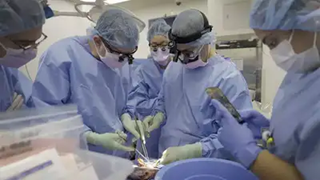
Jonathan D. Grinstein, PhD, the North American Editor of Inside Precision Medicine, hosts a new series called Behind the Breakthroughs that features profiles of the people shaping human healthcare. With each episode, Jonathan gives listeners access to their motivational tales and visions for this emerging, game-changing field.
For many cancer patients today, the question is becoming less about whether there’s a treatment for their condition and more about which one is the right one. Despite tremendous improvement in cancer treatments, there are significant delays in matching patients to targeted therapies. For these medicines to be widely used, genomic profiling with next-generation sequencing (NGS) must first become commonplace. The question is, “How?”
In the second episode of Behind the Breakthroughs, Luca Quagliata, PhD, global head of medical affairs for clinical NGS and oncology at Thermo Fisher Scientific, shares how his career has been intertwined with precision medicine, beginning with his time as a student in Italy during the early 2000s. Quagliata examines the significance of genomic profiling within the cancer care continuum, outlining the essential steps and touchpoints necessary to ensure the accessibility of personalized oncology treatment for all individuals.
This interview has been edited for length and clarity.
IPM: What drew you to precision medicine?
Quagliata: When my journey started with precision medicine, it was just wording. There was nothing out there. Then, when I started to work, Novartis launched its first targeted therapy [Gleevec in May 2001]. I was very lucky in my professional life because I was right in the middle of that. As I was graduating, there were waves of targeted therapies hitting the market.
My journey started in Italy, where I studied molecular medicine. Then, I got a PhD in pathology and vascular medicine at Heidelberg University in Germany. It was a fantastic time because it was the time when you started to see maturity in the precision medicine field.
I set up one of Europe’s first NGS facilities in Basel. We were among the first to offer NGS for clinical routine diagnostics in Switzerland and across the continent. We had one of Europe’s first diagnostic liquid biopsy cases. It was an incredibly inspiring environment for me. I understood how exciting it was to see new targeted therapies on the market, but there was a gap between therapy and patient, which were the diagnostics.
Precision medicine is not well established. The model has been established, but the full power of precision medicine will only be realized once it is available anywhere in the world. The problem is that precision medicine is currently only a reality in large academic centers or reference centers, not at the community level. We have some fantastic drugs, but are we actually using them? Unfortunately, the answer is no. We are unable to link patients to precision medicines. So, precision medicine will only become a reality once we have established it on a global scale, regardless of where you are. That is my personal mission.
IPM: How do decentralized clinical trials enhance access and equity to precision medicine?
Quagliata: Ultimately, real-world evidence is becoming as important as clinical trials. We need to understand that when conducting trials. We must try to stay as close to reality as possible, and the only way to do that is to be decentralized, which means you cover different geography and areas. If you conduct trials at only one location worldwide, you will have a very select population and do not represent the reality of the world out there. In a decentralized manner, you can be confident that the data you will be producing will be far more fitting to reality once the drug is launched. This is a huge benefit as well to speed up the entire [drug development] process, allowing [targeted therapies] to get to the market and benefit patients faster.
IPM: Who are the most important people to be working with to bring your vision of precision medicine to fruition?
Quagliata: Patients are at the center of everything we do. Every product we generate—I am talking about regulated products that are approved—even during the R&D phase when we are thinking about what we need to do, we bring in the voice of the patient in the development process.
Though laboratory people are our natural, easiest contact to have, we also need to have part of this discussion with pathologists and clinicians. The major difference is that the way we talk to these people, the value proposition might be the same, but the wording is not the same.
Another important piece of the puzzle is to speak with payers and reimbursement experts because, at the end of the day, you can have the best solution in the world, and there are many very good solutions out there. However, if you do not have the appropriate level of access, which includes reimbursement, their impact is limited. The right thing to do is to make things accessible and sustainable so that they can be reimbursed.
Working with Pharma has been another big focus for us in the last five years. We both understand pharma and diagnostics and that we cannot live without each other. It’s an absolute paradigm shift in the field. Pharma now has much better access to pathologists because of us. It’s a mutual benefit of working together because we are connecting the dots. We are creating a favorable environment for making a change.









![Best Weight Loss Supplements [2022-23] New Reports!](https://technologytangle.com/wp-content/uploads/2022/12/p1-1170962-1670840878.png)




